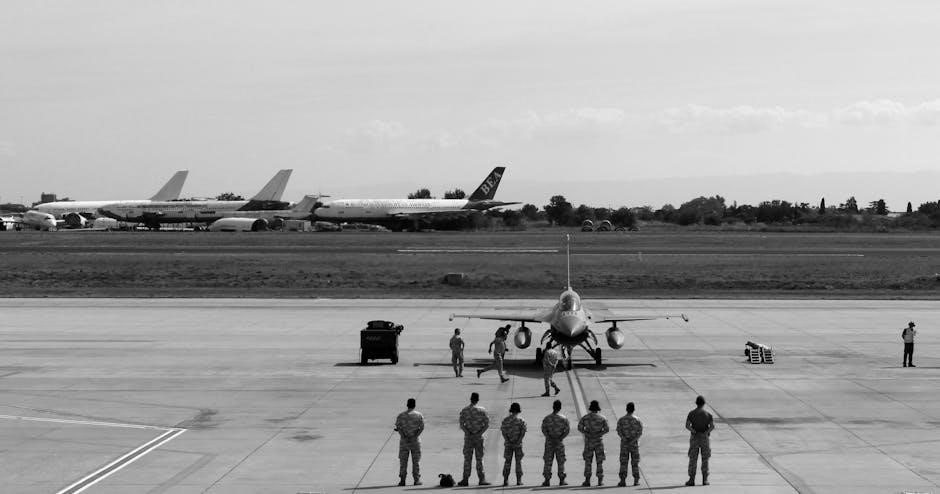The private pilot stage check is a critical evaluation to assess a student’s readiness for the checkride‚ ensuring proficiency in aircraft control and decision-making.
It provides an opportunity for instructors to review progress and address areas needing improvement‚ helping students become well-rounded pilots prepared for real-world scenarios.
Resources like the Private Pilot Oral Exam Guide by Michael D. Hayes and flashcard tools like Quizlet are essential for effective preparation and understanding key concepts.
1.1 Overview of the Stage Check Process
The stage check process is a structured evaluation system designed to assess a student pilot’s progress at specific training phases. It ensures that pilots meet the required standards before advancing to the next level of training. Each stage check focuses on both flight proficiency and knowledge‚ covering critical areas such as aircraft control‚ navigation‚ and decision-making. The process helps identify areas needing improvement and reinforces good habits‚ ultimately preparing students for the final checkride and real-world flying scenarios.
1.2 Importance of the Oral Exam
The oral exam is a critical component of the stage check‚ assessing a pilot’s knowledge and understanding of aviation concepts‚ regulations‚ and safety practices. It evaluates the pilot’s ability to apply theoretical knowledge in real-world scenarios‚ ensuring they can make informed decisions during flight. A well-prepared oral exam demonstrates a pilot’s readiness for the practical test and highlights areas where additional study may be needed. Resources like the Private Pilot Oral Exam Guide and flashcard tools are invaluable for thorough preparation.

Certificates and Documents
Essential documents include a pilot certificate‚ medical certificate‚ and government-issued ID. These verify eligibility to fly and ensure compliance with aviation regulations‚ as outlined in the Private Pilot Oral Exam Guide.
2.1 Required Documents to Fly
To legally operate an aircraft‚ pilots must carry specific documents. For student pilots‚ these include a pilot certificate‚ medical certificate‚ government-issued photo ID‚ and logbook with endorsements. Private pilots also need their pilot certificate‚ medical‚ and photo ID. These documents ensure compliance with regulations and verify a pilot’s qualifications. During a stage check or FAA inspection‚ having these readily available is crucial to avoid operational issues. Additionally‚ understanding the expiration dates and renewal processes for these certificates is essential for maintaining legal flight status.
2.2 Maintaining Your Pilot Certificate
Maintaining a pilot certificate requires adherence to specific regulations. Student pilots must hold a valid medical certificate‚ with expiration based on age. Private pilots‚ however‚ must complete a flight review every 24 calendar months to remain current. Additionally‚ staying updated on FAA regulations and participating in recurrent training ensures continued proficiency. Proper documentation and regular check-ins with flight instructors are essential to maintain legal and safe flight privileges. Understanding these requirements helps pilots avoid lapses in certification and ensures compliance with aviation standards.
2.3 Logbook Endorsements and Sign-offs
Logbook endorsements and sign-offs are critical for tracking progress and ensuring compliance with FAA requirements. Student pilots must obtain instructor endorsements for specific training phases‚ such as solo flights and cross-country trips. Private pilots require endorsements for flight reviews and additional ratings. These entries serve as legal proof of a pilot’s qualifications and training completion. Instructors must sign off on all required training elements before a pilot can advance. Accurate and timely logbook entries are essential for maintaining certification and demonstrating adherence to regulatory standards.
Medical Certificates
Medical certificates are essential for ensuring pilot fitness to fly. Student pilots under 40 require a valid medical certificate every 60 months‚ while those over 40 need renewal every 24 months. Private pilots must maintain a valid medical certificate to exercise flight privileges. The renewal process involves a medical examination by an FAA-designated aviation medical examiner (AME). Keeping your medical certificate current is crucial for compliance with FAA regulations and safe flight operations.
3.1 Types of Medical Certificates
There are three classes of medical certificates: Class I for airline transport pilots‚ Class II for commercial pilots‚ and Class III for private pilots. Each class has different requirements and validity periods. Student pilots typically require a Class III medical certificate‚ which is valid for 60 months under 40 years of age and 24 months over 40. Private pilots must hold a valid Class III medical certificate to fly. The medical examination ensures fitness for flight duties‚ focusing on vision‚ hearing‚ blood pressure‚ and overall health. Regular renewals are necessary to maintain flying privileges.
3.2 Validity and Renewal Process
A student pilot’s medical certificate is valid for 60 months if under 40 or 24 months if over 40. Private pilots must renew their Class III medical certificate every 24 or 60 months‚ depending on age. The renewal process involves passing a medical examination by an FAA-designated Aviation Medical Examiner (AME). Pilots with certain medical conditions may require additional evaluations or special issuance authorizations. Maintaining a valid medical certificate is essential for continued flight privileges‚ ensuring compliance with FAA regulations and safety standards for aviation activities.
3.3 Medical Requirements for Student and Private Pilots
Student pilots must hold a valid medical certificate issued by an FAA-designated Aviation Medical Examiner (AME). Private pilots require a Class III medical certificate‚ renewed every 24 or 60 months‚ depending on age. Both must pass a medical examination to ensure fitness for flight. Certain medical conditions may require special issuance authorizations. Compliance with these requirements is mandatory for maintaining flight privileges‚ ensuring pilots meet safety and regulatory standards set by the FAA.
Privileges and Limitations
Student pilots must carry a valid medical certificate and pilot certificate‚ with specific limitations on solo flights and cross-country operations. Private pilots can fly for personal use‚ but cannot fly for hire or in certain conditions without proper endorsements.
4.1 Limitations as a Student Pilot
Student pilots face specific restrictions during training‚ including no flying for compensation or hire and requiring instructor endorsements for solo flights and cross-country operations. Additionally‚ they must adhere to medical certificate validity and logbook documentation requirements. These limitations ensure safety and compliance with FAA regulations‚ preparing them for the responsibilities of a private pilot certificate. Understanding these restrictions is crucial for successful progression in flight training‚ as outlined in the Private Pilot Stage Check Oral Guide.
4.2 Privileges of a Private Pilot Certificate
Earning a private pilot certificate grants the freedom to fly for personal enjoyment‚ carrying passengers‚ and sharing the joy of aviation. Pilots can operate aircraft within specified categories and classes‚ daytime or night‚ under visual flight rules (VFR). Additionally‚ private pilots can fly internationally‚ provided they meet the destination country’s requirements. These privileges‚ as detailed in the Private Pilot Stage Check Oral Guide‚ offer a fulfilling experience while adhering to FAA regulations and maintaining flight proficiency through regular reviews. This certification opens doors to endless aviation adventures and opportunities.

Aircraft Airworthiness
Aircraft airworthiness ensures the plane is safe and legally compliant for flight. Regular inspections‚ such as annual and 100-hour checks‚ are mandatory. A pre-flight inspection checklist guarantees all systems function properly‚ maintaining airworthiness and safety.
5.1 Required Inspections and Maintenance
Regular inspections and maintenance are vital to ensure aircraft airworthiness. Annual inspections‚ 100-hour inspections for commercial use‚ and pre-flight checks are mandatory. These ensure compliance with FAA standards.
Maintaining accurate records of inspections and repairs is crucial. Pilots must verify that all Airworthiness Directives (ADs) are complied with. Proper maintenance ensures safety and legal compliance for flight operations.
5.2 Pre-Flight Inspection Checklist
A thorough pre-flight inspection ensures aircraft airworthiness. Start with external checks: inspect the propeller‚ tires‚ flaps‚ and control surfaces for damage. Verify oil and fuel levels‚ and check for leaks or obstructions in the air intakes and pitot tube.
Internal checks include examining the instrument panel‚ circuit breakers‚ and seatbelts. Ensure all avionics and navigation systems are functioning properly. Review the aircraft’s logbooks and ensure all required documents‚ like the Airworthiness Certificate‚ are onboard. Adhering to a detailed checklist guarantees safety and compliance with FAR/AIM and AC 00-45G guidelines.
Flight Planning and Performance
Flight planning involves calculating fuel‚ time‚ and route‚ while performance assessments determine aircraft capabilities. Accurate takeoff and landing distances‚ climb rates‚ and cruise altitudes ensure safe and efficient flight operations.
Referencing the Private Pilot Oral Exam Guide and Aircraft Performance Guide provides detailed methods for these calculations‚ ensuring compliance with FAA standards and safe flight practices.
6.1 Fundamentals of Flight Planning
Flight planning is essential for safe and efficient flying. It involves calculating fuel requirements‚ estimating flight time‚ and determining the most suitable route. Pilots must consider weather conditions‚ airspace restrictions‚ and emergency procedures. Understanding aircraft performance‚ including takeoff and landing distances‚ is critical for planning. Proper planning ensures compliance with FAA regulations and minimizes risks. Using tools like the Pilot’s Operating Handbook (POH)‚ navigation charts‚ and weather reports helps in creating an accurate and reliable flight plan. This step is vital for both student pilots and private pilots during stage checks.
Additionally‚ pilots must file a flight plan when required and communicate with air traffic control. Knowing how to adjust plans for unexpected changes‚ such as weather deviations or air traffic delays‚ is also crucial. The Private Pilot Oral Exam Guide provides detailed questions and answers to help prepare for this aspect of the stage check‚ ensuring a thorough understanding of flight planning principles and practices.
6.2 Calculating Aircraft Performance
Calculating aircraft performance is vital for ensuring safe operations. This includes determining takeoff and landing distances‚ climb rates‚ and cruise speeds. Pilots use the Aircraft Flight Manual (AFM) and performance charts to make accurate calculations. Factors such as weight‚ altitude‚ temperature‚ and wind affect performance. Understanding how to adjust for these variables is crucial. For example‚ high altitude or hot weather can reduce aircraft performance. During stage checks‚ pilots must demonstrate the ability to calculate performance accurately‚ ensuring safety and compliance with FAA regulations. This skill is essential for both student and private pilots.
Additionally‚ pilots must consider fuel consumption rates and payload limits. Proper calculation helps in avoiding exceedance of aircraft limitations. The Private Pilot Oral Exam Guide provides detailed guidance on performance calculations‚ aiding in effective preparation for the stage check and real-world flying scenarios.

Weather Considerations
Weather considerations are critical for safe flight operations. Pilots must understand wind shear‚ thunderstorms‚ and icing conditions. Sources like METARs and TAFs provide essential data. Proper weather decision-making ensures safety and regulatory compliance. The Private Pilot Oral Exam Guide and Quizlet flashcards aid in preparing for related exam questions‚ emphasizing the importance of accurate interpretations and sound judgment during pre-flight and in-flight phases.
7.1 Sources of Weather Information
Understanding weather sources is vital for flight planning. Pilots rely on METARs for current conditions‚ TAFs for forecasts‚ AIRMETs for en route hazards‚ and SIGMETs for severe weather. ATIS provides airport-specific data‚ while PIREPs offer real-time pilot reports. The Private Pilot Oral Exam Guide emphasizes the importance of interpreting these sources accurately. Additionally‚ tools like Quizlet flashcards help students memorize key weather terms and concepts‚ ensuring readiness for the oral exam. Accurate weather information is crucial for safe and compliant flight operations.
7.2 Weather Decision Making for Safe Flying
Weather decision-making is critical for safe flying. Pilots must evaluate METARs‚ TAFs‚ AIRMETs‚ and SIGMETs to assess flight conditions. Understanding wind shear‚ thunderstorms‚ and icing conditions is essential. Personal weather minimums should guide go/no-go decisions. The Private Pilot Oral Exam Guide emphasizes interpreting weather data accurately. Quizlet flashcards help memorize key terms like “cumulus‚ mature‚ dissipating” for thunderstorm stages. Effective weather planning ensures compliance with regulations and enhances safety‚ making it a cornerstone of responsible flight operations.

Navigation Techniques
Navigation involves pilotage‚ dead reckoning‚ and electronic aids. Understanding maps‚ compasses‚ and GPS is crucial. These tools help pilots determine position‚ course‚ and altitude accurately during flight.
8.1 Fundamentals of Navigation
Navigation is a core skill for pilots‚ combining pilotage‚ dead reckoning‚ and electronic aids. Pilotage uses landmarks and charts to guide‚ while dead reckoning relies on time‚ speed‚ and headings. Electronic tools like GPS‚ VOR‚ and NDBs enhance accuracy. Understanding these methods ensures precise tracking of position‚ altitude‚ and course. Familiarity with maps‚ compasses‚ and waypoints is essential. This foundation allows pilots to navigate safely and efficiently‚ even in challenging conditions‚ ensuring adherence to flight plans and regulations.
8.2 Using Instruments and Tools for Navigation
Modern navigation relies on a variety of instruments like GPS‚ VOR‚ and NDBs‚ which provide precise location and directional data. GPS offers accurate position tracking‚ while VORs and NDBs help determine bearings and radial intercepts. Pilots must understand how to interpret these tools alongside traditional methods. Regular practice with navigation instruments ensures proficiency and situational awareness. Familiarity with electronic flight instruments and their integration into cockpit systems is crucial for safe and efficient flight operations‚ enhancing overall navigation accuracy and adherence to flight plans.

Federal Aviation Regulations
Federal Aviation Regulations (FARs) govern pilot conduct‚ aircraft operations‚ and safety standards. Key regs include FAR 61 for certification‚ FAR 91 for general operating rules‚ and FAR 43 for maintenance.
9.1 Overview of Relevant FARs
Federal Aviation Regulations (FARs) are critical for private pilots to understand and comply with. Key regulations include FAR 61‚ which governs pilot certification requirements‚ such as medical certificates‚ logbook endorsements‚ and flight reviews. FAR 91 outlines general operating rules‚ including pre-flight actions‚ airspace restrictions‚ and weather minimums. FAR 43 addresses aircraft maintenance and airworthiness standards. Understanding these regulations ensures legal compliance and safe flight operations. These FARs are frequently discussed during oral exams‚ as they form the foundation of a pilot’s responsibilities and operational guidelines.
9.2 Compliance with FAA Regulations
Adhering to FAA regulations is essential for maintaining certification and ensuring safety. Pilots must carry valid documents‚ conduct regular medical checks‚ and complete flight reviews as mandated. Compliance with FARs‚ such as those in Part 91‚ ensures adherence to operational standards‚ including pre-flight procedures and weather minimums. Proper documentation and timely renewals prevent legal issues and groundings. Understanding and following these regulations demonstrates professionalism and commitment to safety‚ which are key areas of focus during the oral exam and practical test.

Safety Procedures
Safety procedures are crucial for minimizing risks and ensuring safe flight operations. Pre-flight checks‚ weather assessments‚ and emergency preparedness are key components that every pilot must rigorously follow.
10.1 Pre-Flight Safety Checks
Pre-flight safety checks are essential to ensure the aircraft is airworthy. These checks include inspecting the exterior for damage‚ verifying control surfaces‚ and checking fluid levels. Pilots must also review weather conditions‚ NOTAMs‚ and aircraft performance data. Inside the cockpit‚ all instruments‚ navigation systems‚ and communication devices must be tested. Additionally‚ ensuring the presence of required documents‚ such as the pilot’s certificate‚ medical certificate‚ and government-issued ID‚ is crucial. A thorough pre-flight routine helps identify potential issues before takeoff‚ enhancing overall flight safety and preparedness for any situation. Regular practice of these checks ensures they become second nature‚ reducing the risk of oversights that could lead to accidents. By adhering to a structured pre-flight checklist‚ pilots can confidently address each critical aspect of the aircraft’s readiness‚ contributing to a safer and more efficient flight experience. Consistency in these procedures is vital for maintaining a high standard of safety in aviation operations.
10.2 In-Flight Safety Protocols
In-flight safety protocols are critical for maintaining control and responding to emergencies. Pilots must continuously monitor instruments‚ weather‚ and traffic‚ adjusting course as needed. Effective communication with ATC and other aircraft is essential‚ especially in busy airspace. In case of system failures or medical emergencies‚ having a pre-planned course of action ensures prompt response. Regular checklists‚ such as those for altitude changes or system malfunctions‚ help maintain situational awareness. Staying vigilant and prepared for unexpected situations minimizes risks‚ ensuring a safe outcome for all on board. Consistent adherence to these protocols is key to safe flight operations.

Flight Maneuvers
Flight maneuvers are fundamental skills assessed during the stage check. They include basic and advanced techniques‚ such as turns‚ climbs‚ and emergency procedures. Understanding common errors improves performance and safety. Consistent practice ensures smooth and precise aircraft control.
11.1 Basic Flight Maneuvers
Basic flight maneuvers are essential for every pilot‚ including climbs‚ descents‚ turns‚ and straight-and-level flight. Proper techniques ensure safety and control. Common errors‚ like over-controlling or improper pitch attitudes‚ must be corrected. Consistent practice builds proficiency in these fundamental skills‚ which are critical for safe flight operations. Understanding and mastering these maneuvers is vital for progressing to advanced techniques and handling various flight scenarios effectively.
11.2 Advanced Flight Maneuvers
Advanced flight maneuvers‚ such as steep turns‚ slow flight‚ and emergency procedures‚ are critical for handling unusual attitudes and unexpected situations. Steep turns require precise pitch and bank control‚ while slow flight tests aircraft behavior near stall speeds. Common errors include insufficient pitch control and overbanking. Correcting these involves smooth‚ coordinated inputs. Mastery of these maneuvers is vital for safe operations and emergency handling. They are also key components of the private pilot stage check‚ ensuring pilots can manage challenging conditions effectively and maintain control in critical scenarios.
11.3 Common Errors and Corrections
Common errors during flight maneuvers include improper pitch control during steep turns and inadequate stall recovery techniques. Overbanking in turns and failure to maintain altitude are frequent mistakes. To correct these‚ focus on smooth‚ coordinated inputs and consistent use of checklists. For stalls‚ apply full throttle and reduce pitch immediately. Proper preparation and practice are key to avoiding these errors. Regular review of the Private Pilot Oral Exam Guide and flight instructor feedback can help refine skills and ensure safe‚ precise maneuver execution.

Emergency Procedures
Understanding emergency protocols is crucial for safe outcomes. Regular practice of procedures like engine failures‚ system malfunctions‚ and medical emergencies ensures quick‚ effective responses. Stay calm‚ declare emergencies when needed‚ and prioritize evacuation if necessary. Reviewing checklists and staying prepared is vital for handling unexpected situations confidently.
12.1 Emergency Protocols and Checklists
Emergency protocols and checklists are essential for managing unexpected situations. Pilots must memorize procedures for engine failures‚ system malfunctions‚ and medical emergencies; Always prioritize safety and follow structured checklists to ensure no steps are missed. Regular practice of these protocols enhances reaction time and decision-making. The FAA recommends reviewing emergency procedures in the Private Pilot Oral Exam Guide and staying calm during crises. Knowing when to declare an emergency and how to communicate effectively is crucial for safe outcomes. Preparation and familiarity with checklists are vital for handling emergencies confidently.
12.2 Handling Emergency Situations
Handling emergency situations requires calm and quick decision-making. Pilots should stay alert‚ assess the situation‚ and execute memorized procedures. Effective communication with ATC and passengers is critical. Regular training and scenario practice build confidence and readiness. The Private Pilot Oral Exam Guide emphasizes the importance of recognizing emergency signs early and following checklists. Prioritizing safety and maintaining aircraft control are key to managing crises effectively. Preparation and composure ensure better outcomes in high-pressure situations‚ making emergency handling a fundamental skill for all pilots.

Common Mistakes During Oral Exams
Common mistakes include lack of thorough preparation‚ poor understanding of regulations‚ and inability to articulate concepts clearly. Pilots often underestimate the depth of knowledge required.
Practicing with mock interviews and reviewing key topics‚ as outlined in the Private Pilot Oral Exam Guide‚ can help mitigate these errors and improve performance during the exam.
13.1 Areas of Focus for Examiners
Examiners focus on critical areas such as knowledge of certificates‚ medical requirements‚ and aircraft airworthiness. They also assess understanding of weather interpretation‚ federal regulations‚ and flight planning. Additionally‚ navigation techniques and emergency procedures are key topics. Clear communication and practical application of knowledge are essential for success.
- Certificates and documents required to fly.
- Medical certificate validity and requirements.
- Aircraft airworthiness and inspections.
- Weather decision-making and sources of information.
- Navigation tools and techniques.
- Emergency procedures and protocols.
13.2 Tips for Successful Preparation
Thorough preparation is key to excelling in the oral exam. Review FARs‚ PHAK‚ and ACs regularly. Use study guides like the ASA Oral Exam Guide and Quizlet flashcards to reinforce knowledge. Practice mock interviews with instructors to simulate exam conditions. Focus on understanding concepts rather than memorizing answers. Stay organized by categorizing topics and tracking progress. Regular review of checklists and logbooks ensures familiarity with documentation. Engage in active learning by teaching concepts to peers‚ enhancing retention and clarity.
Final Preparation
Review key topics‚ organize documents‚ and practice mock interviews to build confidence. Ensure all logbook endorsements are current and understand the exam format to feel fully prepared.
14.1 Reviewing Key Topics
Focus on critical areas such as aircraft airworthiness‚ weather decision-making‚ and emergency procedures. Utilize study guides like the Private Pilot Oral Exam Guide to cover FARs‚ navigation‚ and performance calculations.
Organize your notes and ensure familiarity with the POH. Practice explaining concepts aloud to enhance clarity and confidence during the oral exam.
14.2 Practicing with Mock Interviews
Engage in mock interviews with instructors or experienced pilots to simulate real exam conditions. Use flashcards from tools like Quizlet to practice answering questions on topics such as certificates‚ weather‚ and navigation.
Focus on improving communication skills and maintaining composure under pressure. Each session provides valuable feedback‚ helping refine responses and build confidence for the actual oral exam.



